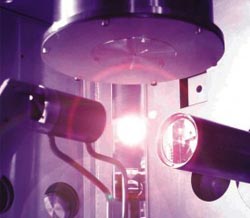Ultraviolet Light to the Extreme

ETH-Zurich/B.Newton<br><br>Plasma generated by blasting droplets with a laser 6000 times a second <br>
When you heat a tiny droplet of liquid tin with a laser, plasma forms on the surface of the droplet and produces extreme ultraviolet (EUV) light, which has a higher frequency and greater energy than normal ultraviolet.
Now, for the first time, researchers have mapped this EUV emission and developed a theoretical model that explains how the emission depends on the three-dimensional shape of the plasma. In doing so, they found a previously untapped source of EUV light, which could be useful for various applications including semiconductor lithography, the process used to make integrated circuits.
In the experiments, Andrea Giovannini and Reza Abhari from ETH-Zurich in Switzerland blasted a 30-micron-diameter droplet of tin with a high-powered laser 6,000 times a second. They measured the spatial distribution of the resulting EUV emission and found that 30 percent of it came from behind the region of the droplet that was struck by the laser. According to their model, this unexpected distribution was due to the fact that the plasma partially surrounding the droplet was elongated in the direction of the laser pulse.
Devices that produce narrow beams of EUV for purposes like in semiconductor lithography use mirrors to focus the emission. But, until now, no one knew to collect the EUV light radiating from behind the droplet.
Thanks to this work, Giovannini said, future devices can exploit this previously unknown source of EUV emission. The new experiments can also inform the development of EUV devices by showing where mirrors should be placed around a droplet in order to collect and focus as much EUV light as possible.
The researchers describe their experiments in the Journal of Applied Physics, which is produced by AIP Publishing.
The paper, “Three-dimensional extreme ultraviolet emission from a droplet-based laser-produced plasma” by Andrea Z. Giovannini and Reza S. Abhari appears in the Journal of Applied Physics. See: http://dx.doi.org/10.1063/1.4815955
ABOUT THE JOURNAL
Journal of Applied Physics is an influential international journal publishing significant new experimental and theoretical results of applied physics research. See: http://jap.aip.org
Media Contact
More Information:
http://www.aip.orgAll latest news from the category: Physics and Astronomy
This area deals with the fundamental laws and building blocks of nature and how they interact, the properties and the behavior of matter, and research into space and time and their structures.
innovations-report provides in-depth reports and articles on subjects such as astrophysics, laser technologies, nuclear, quantum, particle and solid-state physics, nanotechnologies, planetary research and findings (Mars, Venus) and developments related to the Hubble Telescope.
Newest articles

Superradiant atoms could push the boundaries of how precisely time can be measured
Superradiant atoms can help us measure time more precisely than ever. In a new study, researchers from the University of Copenhagen present a new method for measuring the time interval,…

Ion thermoelectric conversion devices for near room temperature
The electrode sheet of the thermoelectric device consists of ionic hydrogel, which is sandwiched between the electrodes to form, and the Prussian blue on the electrode undergoes a redox reaction…

Zap Energy achieves 37-million-degree temperatures in a compact device
New publication reports record electron temperatures for a small-scale, sheared-flow-stabilized Z-pinch fusion device. In the nine decades since humans first produced fusion reactions, only a few fusion technologies have demonstrated…





















